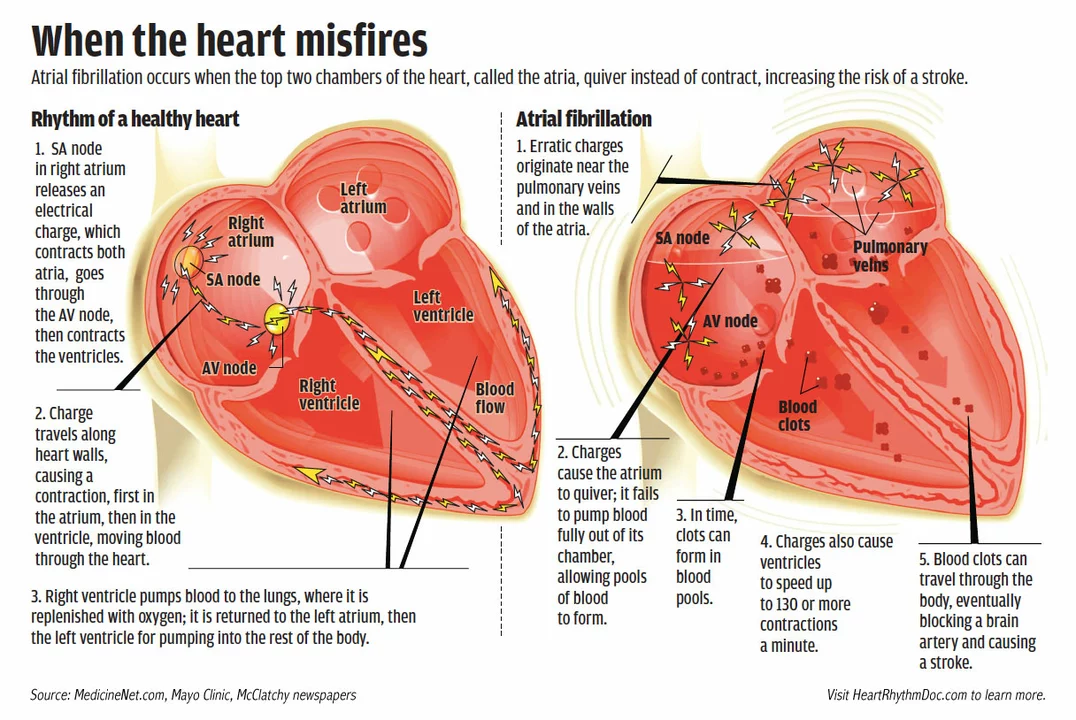Atrial Fibrillation Explained: What You Need to Know
If your heart feels like it’s skipping beats or racing for no reason, you might be dealing with atrial fibrillation (AFib). It’s the most common irregular heartbeat and affects millions worldwide. The good news is that understanding AFib helps you take control of symptoms and lower risks.
Spotting the Signs
Typical AFib clues include a fluttering sensation in the chest, shortness of breath, fatigue, or dizziness. Some people hear an irregular pulse when they feel their neck or wrist. Episodes can come and go (paroxysmal) or stick around (persistent). If any of these pop up, especially during light activity, it’s worth getting checked.
How Doctors Diagnose AFib
A simple ECG (electrocardiogram) catches the irregular rhythm in seconds. Sometimes doctors use a Holter monitor that records heartbeats for 24‑48 hours to catch occasional episodes. Blood tests, echo scans, or stress tests might follow to see if other heart problems are present.
Once AFib is confirmed, treatment focuses on three goals: control the heart rate, restore normal rhythm when possible, and prevent blood clots that can cause strokes.
Medication Options
Rate‑control drugs like beta‑blockers or calcium channel blockers keep the heartbeat steady. Rhythm‑restoring pills such as amiodarone aim to bring the heart back to a regular beat, but they have side effects and need careful monitoring.
If you’re at higher risk of stroke, doctors usually prescribe blood thinners—warfarin or newer direct oral anticoagulants (DOACs) like apixaban. These reduce clot formation without requiring frequent lab visits for most people.
Procedures That Can Help
Electrical cardioversion delivers a brief shock to reset the rhythm. It’s quick and often done under mild sedation.
Catheter ablation targets the tiny heart tissue that triggers AFib. A doctor threads a catheter through a blood vessel, heats or freezes the problem area, and many patients stay in normal rhythm for years after.
Lifestyle Tweaks That Make a Difference
Cutting back on caffeine, alcohol, and nicotine can lower episode frequency. Regular exercise—like brisk walking for 30 minutes most days—helps heart health without overexertion.
Managing weight, blood pressure, and sleep apnea are big wins. Even a modest 5‑10% weight loss can reduce AFib episodes dramatically.
Keeping Track of Your Heart
Wearable devices that record heart rhythm are handy for spotting irregular beats early. If you notice a pattern, note the time, activity, and any triggers before sharing it with your doctor.
Stay on top of follow‑up appointments. Adjusting meds or deciding on an ablation often depends on how well you’re doing over weeks and months.
When to Call a Doctor
If you feel sudden, severe shortness of breath, chest pain, or weakness in one side of your body, treat it as an emergency—these could be signs of a stroke.
For milder symptoms that linger or worsen, schedule a visit. Early intervention usually means fewer complications later.
Atrial fibrillation may feel scary, but with the right mix of medication, possible procedures, and everyday habits, you can keep it under control and protect your heart.

